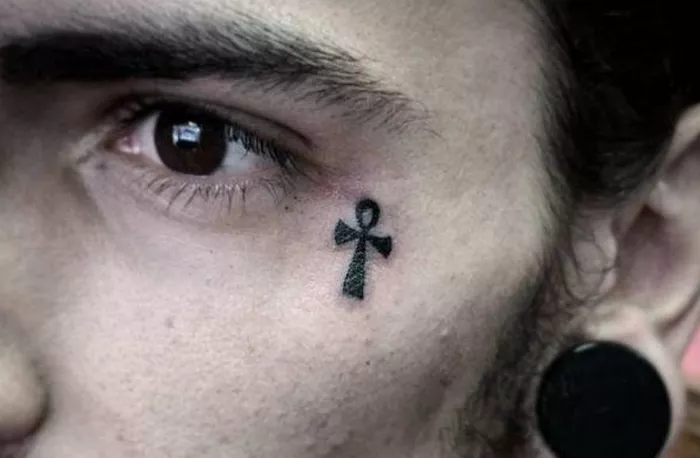Tattoos have long been a medium of personal expression, cultural affiliation, and even social signaling. Among the myriad designs and placements, one of the most enigmatic and controversial is the cross tattoo under the eye. This small, conspicuous symbol carries a wealth of meanings that vary significantly depending on cultural context, individual intent, and social perception. This article delves into the multifaceted interpretations of the cross tattoo under the eye, exploring its historical origins, cultural significance, and the diverse messages it conveys in different settings.
Historical Context and Evolution of Facial Tattoos
Ancient and Indigenous Cultures
Facial tattoos have a deep-rooted history in various ancient and indigenous cultures around the world. In many societies, these tattoos were more than mere decorations; they held significant cultural, spiritual, and social meanings. For instance, the Maori of New Zealand have a long tradition of facial tattoos known as “moko,” which denote lineage, social status, and personal achievements. Similarly, in Arctic regions, Inuit women used facial tattoos to signify marital status, community belonging, and rites of passage.
Modern Evolution
In contemporary times, facial tattoos have evolved from these traditional roots into a form of personal and artistic expression. The cross tattoo under the eye is a relatively recent phenomenon, popularized in part by its visibility in the media, particularly within music and celebrity culture. This evolution has seen the symbol adopt a variety of meanings that often intersect cultural lines, blending traditional symbolism with modern interpretations.
Symbolism of the Cross Tattoo
Religious Significance
The cross is a potent symbol in Christianity, representing faith, sacrifice, and redemption. For many, a cross tattoo under the eye may signify a deeply personal commitment to their faith, a constant reminder of their spiritual beliefs, or a tribute to a loved one. This interpretation is often rooted in the individual’s personal connection to their religion and their desire to carry a visible sign of their faith.
Memorial and Tribute
Another common interpretation of the cross tattoo under the eye is as a memorial or tribute to someone who has passed away. The placement under the eye suggests that the individual is constantly keeping the memory of their loved one close, symbolizing tears or mourning. This usage highlights the emotional and personal dimensions of the tattoo, transforming it into a symbol of loss, remembrance, and enduring love.
Cultural and Social Interpretations
Gang Affiliation
In some contexts, particularly within certain gang cultures, the cross tattoo under the eye can signify membership, loyalty, or a particular status within the group. This interpretation is more prevalent in regions with high gang activity, where tattoos often serve as markers of identity and allegiance. It’s important to note that this meaning is highly context-specific and can vary significantly from one group to another.
Prison Culture
Within prison culture, facial tattoos, including the cross under the eye, can convey various messages. These might include serving as a form of protection, a declaration of one’s criminal record, or even a marker of time served. The specific meaning can vary greatly depending on the prison system and the individual’s experiences. In this environment, the tattoo becomes a powerful symbol of survival, resilience, and identity.
See Also: 15 Incredible Japanese Dragon Tattoo Designs To Inspire You
Influence of Popular Culture
Music and Celebrity Influence
The rise of facial tattoos in popular culture, particularly among musicians and celebrities, has significantly influenced the perception and adoption of the cross tattoo under the eye. Artists in the hip-hop and rap scenes, such as Lil Wayne and Post Malone, have prominently displayed facial tattoos, including crosses. For fans and followers, these tattoos can serve as symbols of rebellion, artistic expression, and identification with the celebrity’s persona.
Media Representation
Media portrayal of individuals with facial tattoos often shapes public perception. In movies, television, and news, facial tattoos are sometimes associated with criminality, rebellion, or outsider status. This portrayal can influence societal views, contributing to a complex and often stigmatized perception of facial tattoos.
Personal Motivations and Interpretations
Individual Stories
For many, the cross tattoo under the eye carries a deeply personal meaning that transcends broader cultural or social interpretations. These individual stories can be as varied as the people who bear the tattoo, encompassing reasons such as personal milestones, transformative life experiences, or a desire to stand out and express unique aspects of their identity.
Psychological and Emotional Factors
The decision to get a facial tattoo, especially one as visible as under the eye, often involves significant psychological and emotional considerations. Factors such as self-identity, personal empowerment, and the desire for visibility can play crucial roles. For some, the tattoo represents a form of emotional catharsis or a permanent reminder of a pivotal moment in their lives.
Societal Perception and Impact
Stigma and Acceptance
Despite increasing visibility in popular culture, facial tattoos, including the cross under the eye, still face significant societal stigma. This can manifest in various ways, including employment discrimination, social alienation, and negative stereotypes. Understanding these challenges is essential for appreciating the complex dynamics surrounding facial tattoos.
Changing Attitudes
However, attitudes towards facial tattoos are gradually shifting. Younger generations, in particular, tend to view tattoos more favorably, seeing them as legitimate forms of self-expression rather than deviant behavior. This changing perception is helping to reduce stigma and promote greater acceptance of tattoos in diverse social contexts.
Conclusion
The cross tattoo under the eye is a symbol rich with varied meanings, encompassing religious devotion, personal tributes, cultural affiliations, and social signals. Its significance is deeply personal and context-dependent, reflecting the complex interplay of individual intent, cultural background, and societal perception. As facial tattoos continue to evolve within modern culture, the meanings attributed to the cross under the eye will likely expand, further enriching this small but powerful symbol’s tapestry of interpretations. Understanding these diverse meanings allows for a deeper appreciation of the personal and cultural narratives that facial tattoos convey, highlighting their role as profound expressions of identity and belief.

